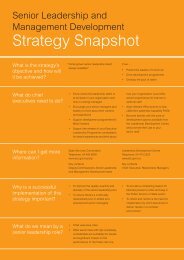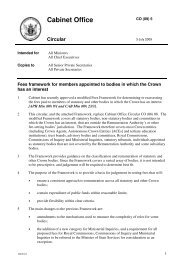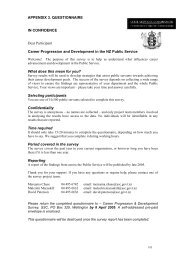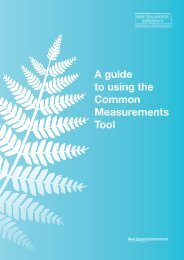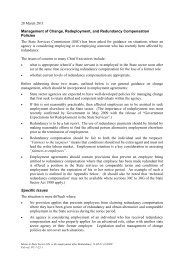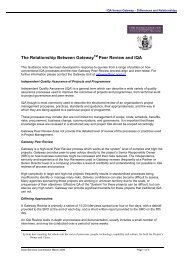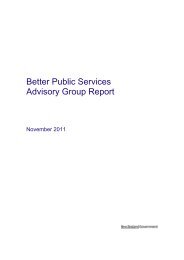Performance Measurement Text.indd - State Services Commission
Performance Measurement Text.indd - State Services Commission
Performance Measurement Text.indd - State Services Commission
You also want an ePaper? Increase the reach of your titles
YUMPU automatically turns print PDFs into web optimized ePapers that Google loves.
MODULE 4 – DEFINING OUTCOMES, INTERMEDIATE OUTCOMES AND OUTPUTS<br />
Definition tips<br />
Prioritise and engage<br />
In developing your definitions, remember that you will need to assess what can be delivered<br />
in different timeframes, given current data and the data improvement plans you will put in<br />
place. Be realistic about what can be achieved in the time that you have available.<br />
A key purpose of performance information is to get sensible reallocation of resources 19 , that<br />
is to be able to reprioritise spending toward the activities that achieve the best outcomes.<br />
This requires open and engaged leaders. The governance structures you put in place will be<br />
critical to achieving this. At a working level, these structures may focus on delivering good<br />
information. At executive level you will need to engage the leaders with the right authority to<br />
make resource decisions about your agency or sector priorities.<br />
Reflect ministerial priorities<br />
Intermediate outcomes and outcomes should reflect ministerial priorities and both your<br />
ongoing operational and statutory responsibilities. They should also be coherent across<br />
your sector. Hence, the engagement strategy defined in Module 3 should be drawn upon at<br />
this step, to create effective engagements upon which shared impacts and outcomes can be<br />
constructed. Other strategy documents produced by agencies should also be coherent and<br />
clearly linked with the definition of the outcomes and impacts used within the performance<br />
measurement process.<br />
Confirm your framework is fit-for-purpose<br />
Before initiating the more labour and cost intensive processes of building data acquisition<br />
and measurement systems, confirm that your framework is coherent by using simple tests.<br />
You will have your own ideas on how to do this against the needs of your sector. Two generic<br />
sets of tests are, however, laid out below to help ensure you have ‘checked all the angles’.<br />
The first test consists of answering some principle questions. Ask yourself if your measures:<br />
• Reflect key priorities of Ministers, and your operational and statutory roles and goals.<br />
• Inform strategy and policy choices, and resourcing decisions.<br />
• Are owned by stakeholders, who must value, trust and use your information.<br />
• Are forward-looking, ensuring that outcomes and intermediate outcomes reflect what<br />
New Zealanders want from you on an enduring basis (vs. what existing outputs might<br />
deliver).<br />
• Are coherent, looking more broadly at your role in the sector, and sector goals.<br />
• Are disaggregated, so that comparisons can be made over time, and across groups or<br />
areas.<br />
• Are clearly defined, so that they are comprehensible to the public, and replicable over<br />
time.<br />
19 Including funding, infrastructure and capabilities more generally.<br />
34 PERFORMANCE MEASUREMENT August 2008




